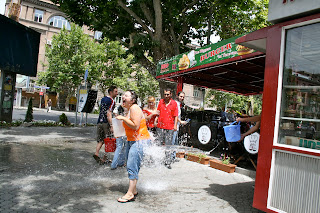 | |
| Vardavar fun in Republic Square |
98 days after Easter Armenia gets wet. Kids throw buckets of water on unsuspecting strangers, fountains turn into swimming pools, and water rains down from balconies onto pedestrians below. This day is called Vardavar, and it is a festival of drenching complete strangers with water. (H/t to Rob for the photos.)
Vardavar started as a pagan homage to Astghik, the goddess of love, beauty, and water, and now the Armenian Church also claims the day. The celebration is historically linked to the harvest, but now it's a chance to douse anyone you want with water.
 |
| Swan Lake water war |
I grabbed my mop bucket around 12pm and headed to Swan Lake (a shallow man made lake in Yerevan's city center) for an epic water war as advertised on Facebook. Before leaving my apartment, my friend coaxed the security guard out of his booth, and I threw a bucket of water on him. This was my first Vardavar dousing and I was a nervous hiding with my bucket behind a bush, but after the drenching he just smiled and gave me a thumbs up, a veritable green light for the day's wet mayhem.
Swan Lake was teeming with young people, thrashing about and dumping water on each other. It didn't take me long to join in, and I soon decided to drench my first dry stranger. As I snuck up behind an old man with my bucket a young kid spied me and he quietly followed suit. When we dumped our buckets on the old guy's head, he quickly spun around and cursed us. The kid and I ran back to the lake for safety, and the old man grumbled on down the street. I then realized that although the whole city knows it's Vardavar, everyone isn't playing.
I joined a gang of American friends and we roamed the streets with buckets and Tupperware containers like a pack of wet dogs. We stopped at Yerevan's many stone drinking fountains to refill, often enduring the watery wrath of the band of kids that already staked claim to the fountain. Occasionally, cars would drive by, lower their windows and spray water from water guns. If we were quick on the draw, we would fling water back at them. Balconies were dangerous. Water could rain down at anytime with smug Yerevanis smiling down with empty buckets from their safe perches above.
 |
| Public Transportation was not spared |
On Vardavar, Yerevan's streets were full of soggy kids, a few dry but weary adults, and the thrill of a citywide prank. The temperature broke 100F that day, and I can't think of a better time to get wet.





























